Paços de Ferreira
Paços de Ferreira (Portuguese pronunciation: [ˈpasuʒ ðɨ fɨˈʁɐjɾɐ] (![]() listen)) is a city in the Porto district, in the north of Portugal. The population of the city in 2011 was 7491, while its municipality had 56,340 inhabitants,[1] in an area of 70.99 km².[2]
listen)) is a city in the Porto district, in the north of Portugal. The population of the city in 2011 was 7491, while its municipality had 56,340 inhabitants,[1] in an area of 70.99 km².[2]
Paços de Ferreira | |
|---|---|
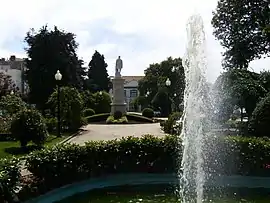 The civic gardens of Paços de Ferreira | |
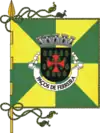 Flag  Coat of arms | |
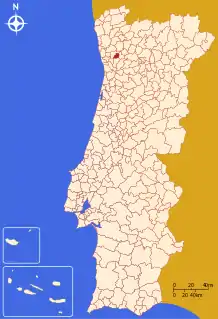 | |
| Coordinates: 41°16′N 8°24′W | |
| Country | |
| Region | Norte |
| Intermunic. comm. | Tâmega e Sousa |
| District | Porto |
| Parishes | 12 |
| Area | |
| • Total | 70.99 km2 (27.41 sq mi) |
| Population (2011) | |
| • Total | 56,340 |
| • Density | 790/km2 (2,100/sq mi) |
| Time zone | UTC±00:00 (WET) |
| • Summer (DST) | UTC+01:00 (WEST) |
| Website | http://www.cm-pacosdeferreira.pt |
Sometimes referred to as the Capital do Móvel (capital of furniture), owing to the predominance of this industry within its territory, the municipality has around 5000 companies producing furniture and has the biggest exhibition and selling area (estimated in 2.5 million square meters) of furniture in Europe. It is also the location of IKEA's industrial operations within Portugal.
Its football team, FC Paços de Ferreira, participated for three times in European Competitions (Champions League and Europa League), finished runners-up of the Portuguese Cup in 2008/2009 and of the Portuguese League Cup in 2010/2011.
History
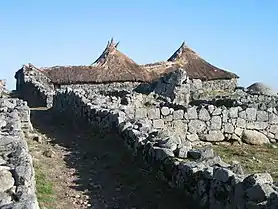
The territory of the current municipality was occupied by humans since prehistory. In the parish of Sanfins de Ferreira, there is an important hillfort, the Citânia de Sanfins, that was one of the main settlements of the Celtic tribes who lived in northwest Iberian Peninsula (Gallaeci).
.jpg.webp)
In medieval times, this planaltic area had few population. The only centers of power were the monastery of Ferreira and the noble families concentrated in the parish of Frazão.
After the Portuguese Civil War, the new constitucional regime made important administrative changes, and, for the first time, granted administrative autonomy for the populations of the region, creating a municipality in 1836 and appointing the most central parish of the plateau, Santa Eulália de Paços de Ferreira, as capital.
Since then, the territory registered a remarkable development, and the population more than sextupled in 150 years.
In the beginnings of the 20th century, a local elementary school teacher, Albino de Matos, invented new tools and furniture which began to be used in schools all around the country, marking the beginning of the furniture industry in Paços de Ferreira. In the second half of the century, with the economic growth of the country, the carpenters of Paços de Ferreira started to make and sell furniture for houses, which allowed the industry to expand, becoming the most important activity of the population.
In 1993 the Portuguese parliament gave the title of city to Paços de Ferreira.
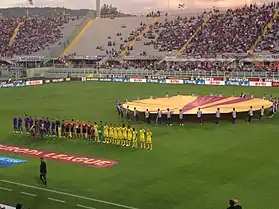
Geography
Administratively, the municipality is divided into 12 civil parishes (freguesias):[3]
- Carvalhosa
- Eiriz
- Ferreira
- Figueiró
- Frazão Arreigada
- Freamunde [city]
- Meixomil
- Paços de Ferreira [city]
- Penamaior
- Raimonda
- Sanfins Lamoso Codessos
- Seroa
| Population of the municipality of Paços de Ferreira (1864 – 2011) | ||||||||||||||
|---|---|---|---|---|---|---|---|---|---|---|---|---|---|---|
| 1864 | 1878 | 1890 | 1900 | 1911 | 1920 | 1930 | 1940 | 1950 | 1960 | 1970 | 1981 | 1991 | 2001 | 2011 |
| 9 627 | 10 226 | 11 361 | 11 900 | 13 924 | 13 864 | 15 686 | 18 697 | 21 999 | 27 537 | 33 655 | 40 687 | 44 190 | 52 985 | 56 340 |
References
| Wikimedia Commons has media related to Paços de Ferreira. |
- Instituto Nacional de Estatística
- "Áreas das freguesias, concelhos, distritos e país". Archived from the original on 2018-11-05. Retrieved 2018-11-05.
- Diário da República. "Law nr. 11-A/2013, page 552 87" (pdf) (in Portuguese). Retrieved 29 July 2014.